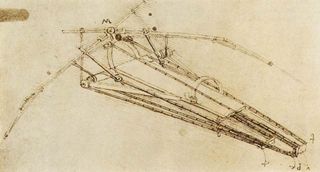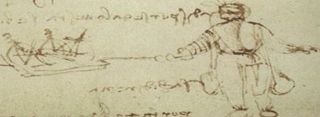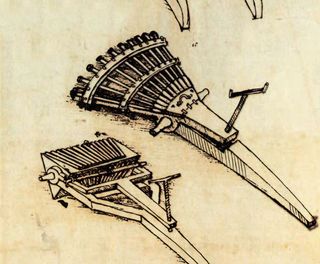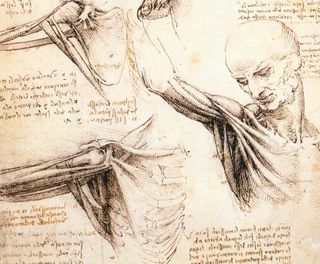Flying Machines? 5 Da Vinci Designs That Were Ahead of Their Time
Most people probably associate Leonardo da Vinci with his great works of art, like the "Mona Lisa" and "The Last Supper," but this Renaissance man was more than just a great painter — he was also an inspired inventor.
Da Vinci sketched out his ideas in notepads, many of which have been preserved since his death in 1519. And while there's no evidence that any of da Vinci's contraptions were built during his lifetime, these sketches show that some of his ideas were revolutionary.
From humanoid robots to machine guns, here are five da Vinci inventions that were truly before their time. [5 Things You Probably Didn't Know About Leonardo da Vinci]

Flying machine
Da Vinci's hundreds of journal entries on human and avian flight suggest he longed to soar through the air like a bird. In fact, his designs for a so-called flying machine — carefully sketched out in his notebooks — were modeled after the anatomy of birds and bats.
Da Vinci's designs featured a pair of enormous wings connected to a wooden frame, inside of which an intrepid pilot could lie facedown and move the wings up and down by turning a crank that moved a series of rods and pulleys. Unfortunately, da Vinci never built the device, but even if he had, it likely wouldn't have been a success. The machine had no engine, so it's unclear how it would get off the ground. And even if da Vinci flew his machine off a high cliff, it's unlikely that he would have returned to Earth in one piece.
The world would have to wait another 400 years or so for a machine that could really fly. It wasn't until 1903 that brothers Wilbur and Orville Wright made their first successful flight in a powered aircraft.
Sign up for the Live Science daily newsletter now
Get the world’s most fascinating discoveries delivered straight to your inbox.

Armored car
Most people know da Vinci as the man behind the "Mona Lisa," "The Last Supper" and other great works of art. But what's often skipped over in history class is the fact that da Vinci also had a more militant side. One of his wealthiest patrons was Ludovico Sforza, then the Duke of Milan, who at the end of the 15th century was charged with defending his Italian state against an invading French army.
To gain Sforza's favor, da Vinci designed a number of instruments of warfare, including an armored vehicle that could be used to thwart the enemy in battle. The invention consisted of a wagon propelled by manpower and covered in sheets of metal. Slits in the metal would allow Italian soldiers to shoot their weapons without being struck by enemy fire.
Like his flying machine, da Vinci's armored car was never built. And it wasn't until 400 years later, during World War I, that armored tanks became a fixture of European battlefields.

Diving suit
Da Vinci wasn't the first inventor to design a suit that can allow humans to "breathe" underwater. However, the artist's diving suit was definitely one of the more thought-out designs. Constructed almost entirely of leather, his suit consisted of a jacket, pants and a mask inlaid with glass goggles. According to his notes, air could be stored in a bulge in the leather jacket to allow for underwater breathing.
The suit also featured a storage container for urine (da Vinci thought the diver would be able to stay submerged for quite some time), as well as various pockets for necessary underwater instruments, such as a knife and a horn to blow to signal the end of the mission.
It wasn't until the middle of the 20th century that the famous inventor and explorer Jacques Cousteau and engineer Emile Gagnan invented the Aqua Lung, or modern scuba suit.

Machine gun
That's right: The same man who painted "The Last Supper" designed a weapon that, at least in some ways, resembles a modern machine gun. Da Vinci's design for a 33-barrelled gun, also called an organ, consisted of 33 small guns mounted on a revolving frame. The gunner could fire the first round of weapons and then turn the frame to fire the next round of weapons almost immediately. Soldiers could then load that second round, fire it and then move on to the third round. [7 Technologies That Transformed Warfare]
Although the system wasn't automatic, it likely would have been an improvement over Renaissance-era artillery. However, the gun was never built. It wasn't until 1862, during the American Civil War, that a rapid-fire weapon — the Gatling Gun — was successfully used in battle.

Humanoid robot
Many of da Vinci's inventions were before his time, but his designs for a humanoid robot were truly futuristic. Under the patronage of Sforza, da Vinci invented a "robotic knight" that could wave its arms, move its neck, and even open and close its mouth. This strange doll was controlled externally by cables operated with a hand crank, as well as by an internal, gear-driven machine.
About 450 years after da Vinci designed his robotic knight, his detailed sketches of the invention were rediscovered. And in the early 21st century, one roboticist took a page from these notes in designing an anthropomorphic robot for the modern age. Mark Rosheim, a roboticist who has built robotic systems for NASA and Lockheed Martin, built a working model of da Vinci's robotic knight in 2002.
Follow Elizabeth Palermo @techEpalermo. Follow Live Science @livescience, Facebook & Google+. Original article on Live Science.

Elizabeth is a former Live Science associate editor and current director of audience development at the Chamber of Commerce. She graduated with a bachelor of arts degree from George Washington University. Elizabeth has traveled throughout the Americas, studying political systems and indigenous cultures and teaching English to students of all ages.
Most Popular



